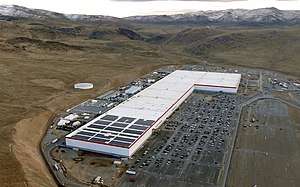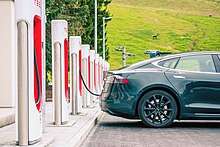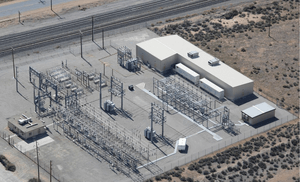Tesla Megapack
The Tesla Megapack is a large-scale lithium-ion battery storage product manufactured and installed by Tesla, Inc.
| Type | Grid energy storage |
|---|---|
| Inception | June 2019 |
| Manufacturer | Tesla Inc. |
| Available | Yes |
| Website | tesla |
Launched in 2019, each Megapack can store up to 3 megawatt-hours (MWh) of electricity. Designed to be deployed by utility companies, Megapacks can be used to store energy generated by intermittent renewable power sources, such as solar and wind. The energy stored can be used by the grid as required, for example during periods of peak electricity demand.
In February 2020, Pacific Gas and Electric Company received approval to deploy 449 Megapacks, to create 730 MWh of energy storage capacity at the Moss Landing substation in Monterey County, California.
History

On April 30 2015, Tesla announced that it would begin to sell standalone battery storage products to consumers and utility companies.[1] Tesla CEO Elon Musk stated that the company's battery storage products could be used to improve the reliability of intermittent renewable energy sources such as solar and wind.[1]
Prior to the launch of the Megapack, Tesla used its 200 kWh Powerpack energy storage product to meet the needs of utility companies with large-scale storage requirements. During 2015 and 2016, Tesla deployed a combined 300 MWh of Powerwall and Powerpack technology, including an 80 MWh deployment of Powerpacks at the Mira Loma substation in Southern California.[2] In 2017, Tesla used Powerpacks to deploy 129 MWh of battery storage at the Hornsdale Power Reserve in South Australia.[3] At the time, this was the biggest deployment of lithium-ion grid battery storage in the world.[4]
Work began on the Megapack project at least as early as the first half of 2018.[5] The Tesla Megapack was designed at Gigafactory 1, in Nevada, USA.[5]
In July 2019, the Tesla Megapack was officially launched.[6]
The Megapack was described by Tesla as a utility-scale energy storage product, suitable for power stations and utility companies.[6] Tesla claimed that Megapacks would be compatible with Tesla power station monitoring and energy control software, Powerhub and Autobidder.[6] The company also stated that the Megapack was designed to meet the needs of large-scale battery storage projects, similar to the Hornsdale Power Reserve.[6]
Specifications
| Model | Technology | Capacity (MWh) | Apparent power (MVA) | Inverter | Dimensions (L x W) | Weight |
|---|---|---|---|---|---|---|
| Megapack | Lithium-ion | Up to 3[7] | Up to 1.54[8] | Bi-directional, 1.5 MW capacity[7] | 23 ft 5 in x 5 ft 3 in (7.14 m x 1.60 m)[9] | 51,000 lbs (23.1 tons)[10] |
Megapacks are currently manufactured at Gigafactory 1.[8] Tesla has stated that it is investing in expanding the factory in order to increase Megapack, Model 3, and Model Y output efficiency.[8]
Megapacks are sold by Tesla's worldwide network of internal sales representatives and external partners.[8] Pricing for Tesla Megapacks is not publicly available.
Each Megapack comes with a 15-year “no defect” and “energy retention” warranty, according to Tesla.[8] A 10 or 20 year "performance guarantee" is also available for an additional cost.[8] Once a Megapack has reached the end of its useful life, it is returned to Tesla to be recycled.[11]
Tesla states that it supplies Megapacks ready-assembled, including “battery modules, bi-directional inverters, a thermal management system, an AC main breaker and controls.”[12]
The Megapack thermal management system is located at the top of each unit.[11] It uses coolant fluid, made of an equal-parts mixture of ethylene glycol and water, to keep the battery at operating temperature.[11]
Maintenance must be performed on each Megapack once every five years, to perform activities such as replacing the pump that powers the thermal management system, and refilling the coolant fluid.[11] Maintenance is expected to take about an hour per Megapack.[11]
Market and use cases
Megapacks are designed to be used for large-scale energy storage. Tesla has stated that Megapacks could be used by utility companies to replace peaker power plants,[13] which generate extra energy during periods of peak demand. Megapacks are designed to store energy that can be later used during periods of surplus demand, rather than a peaker power plant having to generate the energy in real-time using coal or natural gas. It has been shown that grid battery storage can help to reduce power plant carbon dioxide emissions and unit costs of energy production.[14]
Tesla Powerpacks continue to be used by utility companies to meet smaller-scale grid energy storage requirements. For example, a 25 MW / 52 MWh deployment of Powerpacks began testing in November 2019 at the Lake Bonney Wind Farm in South Australia.[15]
Large-scale battery storage solutions such as the Tesla Megapack are becoming more economically viable for utility companies to implement due to the declining price of lithium-ion battery technology.[16] Demand for energy storage is also increasing in some jurisdictions due to transitions towards renewable energy sources.[16] Because renewable energy sources such as solar and wind are more intermittent than coal or natural gas, the energy must be stored in order to fulfil peak-period demand.[17]
Other energy storage solutions, such as pumped hydroelectric storage, continue to dominate the market. As of 2019, pumped hydroelectric storage accounted for 96% of global energy storage capacity.[18] Pumped hydroelectric storage systems have relatively long lifetimes when compared to battery storage.[18]
Battery storage solutions such as the Tesla Megapack can be used in situations where a fast deployment is required, because pumped hydro projects normally take longer to complete when compared to batteries.[19] Tesla has previously used fast deployment as a selling point of its utility-scale battery storage products.[6]
Deployments
Completed deployments

In November 2019, Tesla used a Megapack to power a mobile Supercharger - a recharging station for Tesla electric vehicles - in California.[20] The mobile Supercharger was reported to deliver 125 kW, and was transported on a flat trailer attached to a truck in between deployment locations.[20]
In December 2019, Tesla delivered a 1.25 MW / 2.5 MWh Megapack to the Millidgeville Substation in Saint John, Canada.[10] Saint John Energy, the owner of the Megapack, stated that it will be used for peak shaving.[21] The battery is estimated to save Saint John Energy CA$200,000 per year.[22] Saint John Energy planned to have the Megapack operational by May 2020, and will integrate the battery to work with its grid management software.[21]
Moss Landing project
In June 2018, Pacific Gas and Electric Company (PG&E) requested approval from the California Public Utilities Commission to engage Tesla to deploy a battery storage system in Moss Landing.[23] The system was stated to be capable of producing 182.5 MW for four hours, for a total of 730 MWh of capacity.[9]
The project is designed to improve energy reliability and to allow for more renewable energy sources to be used at the Moss Landing site.[24] The project also aims to save costs by reducing PG&E's reliance on peaker power plants that come online during periods of increased demand.[24] Tesla later confirmed that it would use Megapacks to complete the project.[6]
On July 3 2019, in accordance with the California Environmental Quality Act, the County of Monterey Resource Management Agency published a Mitigated Negative Declaration, detailing actions that must be taken to mitigate potential environmental impacts of the project.[11] The report concluded that the project would have a "Less than Significant Impact" on the environment, assuming the correct mitigating actions were taken.[11] Specifically, it was found that mitigating actions were required to minimise the environmental impact of the project on "biological resources" such as wildlife habitat, and on "cultural resources", especially culturally-significant archaeological sites at the proposed location of the Megapack deployment.[11]
The project was subsequently opened to public submissions on its environmental impact. California Unions for Reliable Energy argued that the County of Monterey failed to meet the standards of the California Environmental Quality Act when performing its environmental assessment.[25] The unions argued that the county should have performed a more thorough investigation into the potential for Tesla's lithium-ion batteries to overheat and explode, potentially harming groundwater purity at the Moss Landing site.[25] They also stated that the county failed to consider the environmental impact of air pollution that would occur during construction.[25]
On February 26 2020, the Monterey County Planning Commission unanimously approved the project, giving PG&E and Tesla permission to proceed with the Megapack deployment.[26]
The project was scheduled to begin in March 2020, with completion estimated at the end of 2020.[9]
Other planned deployments
In May 2020, Strata Solar, an American commercial solar services provider, announced that they would engage Tesla as the battery provider for a 100 MW / 400 MWh energy storage facility in Ventura County, California.[27] The Megapack deployment will replace a natural-gas powered peaker power plant, and will take up three acres of space near the Ventura County Juvenile Justice Center.[28] The project was scheduled to begin in July 2020,[27] with completion expected by January 2021.[28]
Competition

AES Corporation, an American energy company, has been deploying utility-scale lithium-ion batteries since 2007.[29] In 2017, AES Energy Storage, a subsidiary of AES, deployed 30 MW / 120 MWh of lithium-ion batteries in Escondido, California.[30] In January 2018, Fluence Energy, a joint venture of AES and Siemens, announced plans to deploy 100 MW / 400 MWh of batteries at the Alamitos Energy Center in Long Beach, California.[31][32] Construction began in June 2019, and the project is scheduled to be completed at the end of 2020.[31][32]
LG Chem, a Korean chemical company, has been producing lithium-ion batteries since 1999.[33] The company now produces batteries for both consumer and utility-scale use. In 2014, LG Chem supplied 32 MWh of lithium-ion batteries for the Tehachapi Energy Storage Project in Tehachapi, California.[34] At the date of commission, this was the largest battery energy storage facility in North America.[34] In 2017, LG Chem announced that it had more than doubled capacity at its manufacturing plant in Nanjing, China, demonstrating a renewed focus on electric vehicle battery production.[35]
BYD Company Ltd, a Chinese manufacturer of batteries, vehicles, and other battery-powered products, supplies a utility-scale lithium-iron phosphate battery storage product, known as BYD ESS.[36][37] BYD supplied batteries that were used at the 31.5 MW / 12.2 MWh Grand Ridge Battery Storage Facility in LaSalle County, Illinois.[38][39]
Greensmith Energy, an American supplier of energy storage products, deployed 20 MW / 80 MWh of lithium-ion batteries at the Altagas Pomona Substation, in Los Angeles County, California in early 2017.[40][41] Prior to completing the Pomona Substation project, Greensmith had already deployed 180 MW of grid battery storage in the USA.[42] In May 2017, Greensmith was acquired by Wärtsilä Corporation, a Finnish provider of marine and energy equipment.[43] Wärtsilä continues to advertise grid energy storage solutions under the Greensmith trading name.[44]
Toshiba, a diversified Japanese technology company, supplies utility-scale lithium-ion batteries, described by the company as "battery energy storage systems" or BESS.[45] In 2015, Toshiba deployed 40 MW / 20 MWh of batteries at the Nishi-Sendai Substation in Sendai, Japan.[39] In 2016, Toshiba deployed a further 40 MW / 40 MWh of battery storage capacity at the Minami-Soma Substation in Minamisōma, Japan.[39]
NGK Insulators, a Japanese ceramics manufacturer, supplies a utility-scale sodium-sulphur battery storage product.[46] This type of battery is known as a NaS battery, an abbreviation derived from the chemical compounds used in production - sodium (Na) and sulphur (S). In May 2008, 34 MW / 204 MWh of NGK NaS batteries were commissioned for use at a wind farm in Rokkasho, Aomori, Japan.[39] In March 2016, a further 50 MW / 300 MWh of NGK NaS batteries were commissioned at the Buzen Substation in Buzen, Japan.[39]
In comparison to lithium-ion battery technology used by the Tesla Megapack, NaS batteries can allow for cheaper energy storage.[47] The downside of NaS compared to lithium-ion batteries is the chemicals inside the battery must be kept at 350 °C at all times, which can be dangerous.[48][49] In 2011, NGK-made NaS batteries caught fire at the Mitsubishi Materials carbide manufacturing plant in Tsukuba, Japan.[50] The fire was fully extinguished two weeks later.[50] Megapacks do not come with a fire suppression system, because Tesla believes that a Megapack fire could be extinguished with water.[11]
Beginning in April 2016, Japan commenced a process of energy market deregulation,[51] at the same time as the country's consumers were demanding a transition to more renewable energy sources.[52] In February 2020, Tesla representatives attended the International Smart Grid Expo, in Tokyo, Japan, to promote the company's grid energy storage products.[53]
References
- Castelvecchi, Davide (2015-05-01). "Will Tesla's battery change the energy market?". Nature: nature.2015.17469. doi:10.1038/nature.2015.17469. ISSN 0028-0836.
- Lambert, Fred (2017-01-23). "Tesla quietly brings online its massive - biggest in the world - 80 MWh Powerpack station with Southern California Edison". Electrek. Retrieved 2020-04-05.
- Wahlquist, Calla (2018-09-27). "South Australia's Tesla battery on track to make back a third of cost in a year". The Guardian. ISSN 0261-3077. Retrieved 2020-04-05.
- Normile, Dennis (2017-07-07). "Tesla to build titanic battery facility". Science. doi:10.1126/science.aan7072. ISSN 0036-8075.
- Lambert, Fred (2018-10-30). "Tesla is working on a new 'Megapack' energy module at Gigafactory 1". Electrek. Retrieved 2020-04-05.
- "Introducing Megapack: Utility-Scale Energy Storage". www.tesla.com. 2019-07-29. Retrieved 2020-04-05.
- Lambert, Fred (2019-07-29). "Tesla launches its Megapack, a new massive 3 MWh energy storage product". Electrek. Retrieved 2020-04-22.
- "ANNUAL REPORT ON FORM 10-K FOR THE YEAR ENDED DECEMBER 31". Tesla.
- Lambert, Fred (2020-02-27). "Tesla's massive 1GWh Megapack battery project with PG&E is approved". Electrek. Retrieved 2020-04-15.
- "Saint John Energy adding money-saving battery power to its energy grid". Global News. Retrieved 2020-04-05.
- "MITIGATED NEGATIVE DECLARATION". County of Monterey.
- O'Kane, Sean (2019-07-29). "Tesla's Megapack battery is big enough to help grids handle peak demand". The Verge. Retrieved 2020-04-15.
- Vorrath, Sophie (2020-02-28). "World's largest Tesla megapack battery project approved for California". RenewEconomy. Retrieved 2020-04-15.
- Krawczyk, Piotr; Śliwińska, Anna (2020-03-16). "Eco-Efficiency Assessment of the Application of Large-Scale Rechargeable Batteries in a Coal-Fired Power Plant". Energies. 13 (6): 1384. doi:10.3390/en13061384. ISSN 1996-1073.
- Parkinson, Giles (2019-11-05). "Lake Bonney battery charges up for first time in South Australia". RenewEconomy. Retrieved 2020-04-16.
- Stevens, Pippa (2019-12-30). "The battery decade: How energy storage could revolutionize industries in the next 10 years". CNBC. Retrieved 2020-04-16.
- "Grid-Scale Battery Storage Frequently Asked Questions" (PDF). National Renewable Energy Laboratory.
- "U.S. Grid Energy Storage Factsheet | Center for Sustainable Systems". css.umich.edu. Retrieved 2020-04-16.
- "Batteries vs pumped storage hydropower – a place for both?". RenewEconomy. 2017-06-21. Retrieved 2020-04-16.
- Lambert, Fred (2019-11-29). "Tesla deploys new mobile Supercharger powered by Megapack instead of diesel generators". Electrek. Retrieved 2020-04-05.
- McCreadie, Danielle. "Saint John Energy Joins Partnership With Tesla". Country 94. Retrieved 2020-04-05.
- Lambert, Fred (2020-03-09). "Tesla deploys new Megapack in Canada, could save small utility $200,000 per year". Electrek. Retrieved 2020-04-05.
- Lambert, Fred (2018-06-29). "Tesla and PG&E are working on a massive 'up to 1.1 GWh' Powerpack battery system". Electrek. Retrieved 2020-05-27.
- "Tesla's Megapack is a battery built for the electrical grid". Engadget. Retrieved 2020-04-15.
- Shalev, Asaf. "Moss Landing mega battery project faces environmental challenge from union group". Monterey County Weekly. Retrieved 2020-04-05.
- Shalev, Asaf. "PG&E's massive battery storage project at Moss Landing is approved". Monterey County Weekly. Retrieved 2020-04-05.
- "Strata Blazes Ahead With California Gas Peaker Replacement Battery, Taps Tesla". www.greentechmedia.com. Retrieved 2020-05-20.
- Leung, Wendy. "Battery storage project slated near Oxnard will be among the nation's biggest". Ventura County Star. Retrieved 2020-05-20.
- "Long before Tesla made grid batteries cool, there was AES". Fortune. Retrieved 2020-05-27.
- "SDG&E and AES complete world's largest lithium ion battery facility". Energy Storage News. Retrieved 2020-05-27.
- "Essential Energy Insights - May 14, 2020". www.spglobal.com. Retrieved 2020-05-27.
- "100 MW/400 MWh Fluence Energy Storage Project For Long Beach — World's Largest Li-Ion Battery Storage Project". CleanTechnica. 2018-01-24. Retrieved 2020-05-27.
- don (2015-09-20). "LG Chem 2MWh Battery Storage System Commissioned". Energy Matters. Retrieved 2020-05-21.
- "LG Chem operating energy storage system in California". koreajoongangdaily.joins.com. Retrieved 2020-05-21.
- "Subscribe to read | Financial Times". www.ft.com. Retrieved 2020-05-21.
- "Utility ESS". BYD USA. Retrieved 2020-05-21.
- "ABOUT". BYD USA. Retrieved 2020-05-21.
- "Invenergy's Grand Ridge Energy Storage Project enters commercial operation". Power Engineering. 2015-05-29. Retrieved 2020-05-21.
- Perishable. "Global Energy Storage Database | Energy Storage Systems". Retrieved 2020-05-21.
- "How California pulled off the world's fastest grid-scale battery procurement - Part II". Energy Storage News. Retrieved 2020-05-21.
- Spector, Julian (2017-09-15). "California's big battery experiment: a turning point for energy storage?". The Guardian. ISSN 0261-3077. Retrieved 2020-05-21.
- "Tesla, Greensmith, AES Deploy Aliso Canyon Battery Storage in Record Time". www.greentechmedia.com. Retrieved 2020-05-21.
- "Wartsila to Acquire Greensmith for Energy Storage Software". www.greentechmedia.com. Retrieved 2020-05-21.
- "Energy storage". Wartsila.com. Retrieved 2020-05-21.
- "Toshiba Completes Delivery of World's largest Lithium-ion Battery Energy Storage System in Operation --BESS for Tohoku Electric Power Company Begins Operation--". Toshiba. February 2016.
- "NGK's NAS sodium sulfur grid-scale batteries in depth". Energy Storage News. Retrieved 2020-05-21.
- "Grid Battery Storage Options". large.stanford.edu. Retrieved 2020-05-21.
- "Breakthrough boosts performance of sodium-sulfur batteries". phys.org. Retrieved 2020-05-21.
- Ohi, J.M. (September 1992). "Environmental, Health, and Safety Issues of Sodium-Sulfur Batteries for Electric and Hybrid Vehicles" (PDF).
- ClimateWire, Umair Irfan. "Battery Fires Reveal Risks of Storing Large Amounts of Energy". Scientific American. Retrieved 2020-05-21.
- Author, No (2016-09-14). "Power retail deregulation". The Japan Times. Retrieved 2020-05-21.
- "New lease of life: Business models, batteries keep Japan's solar boom afloat". Energy Storage News. Retrieved 2020-05-21.
- "Tesla talks up virtual power plant solutions to target Japan". Energy Storage News. Retrieved 2020-05-21.
